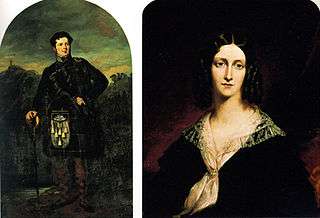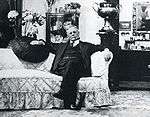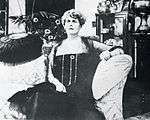Lindesay, Darling Point
_Lyndesay-3.jpg)
Lindesay is a house in Darling Point, Sydney, Australia. It was built in 1834 and is listed by the Heritage Council as a building of historical significance. It was the first major house to be constructed on Darling Point and is aesthetically important as the earliest example of the domestic Gothic style in Sydney.[1] Some of its residents were colourful figures who played an important part in the history of New South Wales. It is owned by the National Trust of Australia.
History
The Riddells who built Lindesay

Campbell Drummond Riddell was born in 1796 in Scotland. His grandfather was Sir James Riddell, first baronet of Ardnamurchan, Argyllshire. In 1829 he joined the colonial service and was sent briefly to Ceylon as a commissioner of inquiry. While he was in Ceylon he met Caroline Stuart Rodney who was the daughter of the government secretary there.[2]
Caroline was born in 1814 in Ceylon and was only 16 when she married Campbell Riddell in 1830 in Colombo. She was part of a very large family. Her father was the Honorable John Rodney and her mother was Lady Louisa Martha Stratford, his second wife. Her mother died when she was a baby and her father married again.[3]
Shortly after the Riddells were married they sailed to Sydney where Campbell was to assume his new appointment as Colonial Treasurer of New South Wales. In 1834 Campbell commenced construction of Lindesay on Darling Point. They moved into the house in 1836 and by this time they had one two-year-old son. They resided at Lindesay for only a short time, less than two years. A notice in the Sydney Gazette for April 1838 said that Caroline had given birth to their second child, a son, at Darlinghurst.[4] Campbell and Caroline had five children altogether, two sons and three daughters.

The Riddells remained in Sydney until 1857 and then returned to England. They took up residence in Regent's Park Terrace which was and still is a very fashionable part of London. The following year in 1858 Campbell died at his home.[5] The Census data for the United Kingdom and other directories show that Caroline remained at Regents Park Terrace for the next 10 years and then moved to 16 Wellington Square in Cheltenham.[6] One of her daughters, Louisa, who did not marry lived with her. Caroline died in 1898 at the age of 84 at her home.[7]
The portrait of Campbell is recorded as having been donated to the Mitchell Library in 1938 by E. Knowles. The second eldest daughter, also named Caroline, married Louis William Knowles so this appears to be a relative. This portrait also has some historical interest. In 1829 before the couple came to Australia it was in an Exhibition of the Royal Academy. Listed as a Portrait of Campbell Riddell Esq by J. Partridge it was favourably mentioned and was one of those described as a "very clever portrait".[8]
After the Riddells left Lindesay in 1838 there were two owners over a very short period. Thomas Icely held the house for about a year and then sold it to James Barker who, with his brother, subdivided the property into eighteen allotments and put them and the house up for sale in 1841. Thomas Mitchell bought the house and some of the land on the same day that it was advertised.[9]
The Mitchell family in residence

Thomas Mitchell was born in 1792 in Scotland. His family was not wealthy but he joined the military and was proficient in drawing up plans of battlefields. In 1818 he married Mary Thomson Blunt who was the eighteen-year-old daughter of General Richard Blunt.[10] In 1827 the couple came to Sydney and Thomas became Assistant Surveyor General of New South Wales and two years later became Surveyor General. During the 1830s Mitchell conducted three major expeditions into the interior of Australia. In 1837 he went to England and published a book about his explorations and obtained his knighthood.[11] He returned to Sydney from England in 1841 and soon after purchased Lindesay.
When the Mitchells came to Lindesay they had been married for 23 years and Mary had borne eleven children, of whom one died in infancy. At this time there were six sons and four daughters all under 22 years of age. While they were living at Lindesay another daughter, Blanche, was born in 1843.[12]
While he was at Lindesay Mitchell was planning to build Carthona also on Darling Point. Besides buying Lindesay on Lot 1 in 1841, Mitchell also bought Lots 7,12,13,14 and 15.[13] It is on the last four lots that Carthona was constructed. In 1845 the Mitchell family moved into Carthona and Mitchell sold Lindesay to his friend Sir Charles Nicholson.
Sir Charles Nicholson as the owner of Lindesay

Sir Charles Nicholson was born in 1808`in England. His parents died while he was young and he was brought up by a maiden aunt in Yorkshire. He obtained a good education and graduated as a medical doctor in 1833. In the same year he came to Sydney with his aunt and joined his uncle Captain James Ascough who was a very wealthy man. A few years later his uncle died and Charles inherited his extensive wealth. He moved to Sydney and in 1843 was elected to the New South Wales Legislative Council and three years later became Speaker of the Council.[14]
By the time he purchased Lindesay in 1845 he had begun to collect rare books, antiquities, pictures and manuscripts.[15] At this stage he was a bachelor and with his considerable wealth he had the time and money to indulge his interest. One visitor to the house said that Nicholson had a very fine library which he thought was one of the largest private libraries in the colony and he also had a special room for his statues.[16]
In 1849 Charles bought Tarmons, a large house at Potts Point and sold Lindesay to William Bradley. After he left Lindesay he played an important part in the establishment of Sydney University and later became its Chancellor. In 1862 he returned to England and married Sarah Keightley. He died in 1903 at the age of 95.[15]
William Bradley and his children

William Bradley was born in New South Wales and was a very wealthy pastoralist. He had extensive grazing lands in the Monaro district and owned the property called Landsdowne near Goulburn. In 1831 he married Emily Hovell daughter of William Hovel, the explorer, and they had eight children, three of whom died at a fairly early age.[17]
In 1843 he became the member for Argyle in the New South Wales Legislative Council. In 1846 he took his family to Europe because of his wife's poor health but unfortunately she died while they were in Rome in 1848.[18] He now had to care for his five daughters alone. He returned to Australia and in 1849 bought Lindesay where he brought up his children. His daughters grew up and eventually married. Sadly his second daughter Esther died at Lindesay in 1856 at age 22. Her death notice records that she had been married to an Englishman, Edward Maitland, and had an infant son.[19]
In 1858 the family went to England for two years. A diary by Georgina Mann indicates that William Baker Boulton may have leased the property during this time as she speaks of the Boultons at a ball there. However it is possible that Mrs Boulton was the housekeeper for Lindesay as there are numerous advertisements in the Sydney Morning Herald for staff for Lindesay in which Mrs Boulton is listed as the person to contact. These occur during and even well before the time the Bradleys left for England.[20] In 1859 there is a birth notice for a son born at Lindesay in the newspaper to Mrs A Rhodes.[21] It is at least possible that the Rhodes were the leasees and the Boultons were staff who perhaps lived at Lindesay.
Mrs A Rhodes (Mary Waud Rhodes (nee Wilson))was the wife of Alexander Rhodes (Civil Engineer). They had married 19 June 1855 at the British Embassy, Paris, Île-de-France, France. Alexander Rhodes had come to New South Wales to work on the construction of the Campbelltown-Picton section of the main Southern line railway line after being appointed Engineer by the firm Messrs. Peto, Brassey and Co. (formerly Messrs. Peto, Brassey and Betts, for whom his cousin Thomas Rhodes Firth had also come to New South Wales to expand the railway network. Thomas R Firth became Civil Engineer-in-Chief for the NSW Rail) (information within family history of A. Firth with original sourcing from certificates and known facts from the family).
In 1868 William Bradley died at Lindesay and the house was bought by John Macintosh who lived there for 43 years and was its longest resident.
The Macintosh family in residence

John Macintosh was born in 1821 in Scotland. His early life was extremely deprived as his parents died when he was 10 and he worked as a farm labourer for a very small wage. When he was 17 he came to Sydney with his sister and brother in law and found work as a labourer on farms and as an assistant in a store. He was self-educated and in 1846 set up as an ironmonger in Sydney and soon had a successful business.[22]
In 1849 he married Caroline Alway and together they further developed their business. In 1861 he became an alderman on the Sydney City Council. When the Macintosh family moved to Lindesay in 1868 they had six children under the age 16. Over the next five years while they were at Lindsay, Caroline had four more children. Unfortunately Caroline died in 1880 at the age of only 46[23] so John Macintosh raised the younger children alone. He did not seek re-election to the Sydney City Council after her death but the following year he was appointed to the New South Wales Legislative Council.[24]
While he was at Lindesay John Macintosh built two other houses on Darling Point for his children. Braeside in 1876 for his daughter Jessie and Cintra in 1882 for his son James. He also built a house at Burradoo. In 1911 John died at Lindesay and Lindesay was sold two years later to Alfred Wunderlich who subdivided the land. In 1914 Dr Edward Jenkins bought the house.[25]
The Jenkins family at Lindesay


Dr Edward Jenkins was born in 1854.[26] He grew up at Parkhall (then renamed Nepean Towers) which was a large house that Thomas Mitchell had built in the Southern Highlands. He won a scholarship to Oxford University where he studied Medicine. He returned to Sydney in 1884 and worked for some time at the Royal Prince Alfred Hospital, Camperdown and later had a private practice in Macquarie Street.[27] In 1887 he married Annie MacCabe who was then 19 years old. They had three children, two sons and a daughter. Edward the eldest son was born in 1888, Osborne was born in 1890 and Merle Judith (usually called Judith) in 1895.[28]
When Edward Jenkins bought Lindsay in 1914 he was 60 and close to retirement. They were a family who enjoyed socialising and many of their outings and holidays are portrayed in family albums as their daughter Judith was a keen photographer. Between 1919 and 1921 the Jenkins travelled abroad and the house was leased to Gwendoline Collins, the recent widow of William Collins of Beaudesert, Queensland.[29]
In 1926 the Jenkins family moved to a smaller house at 35 New South Head Road, Vaucluse. Edward died in 1940 at the age of 86, his wife Annie in 1949 at the age of 81. His daughter Judith did not marry and died at the age of 81 in 1976 in Sydney.[28]
The Pye Family
Lindesay was bought by Charles and Mary Pye in 1926. Charles was born 1860 at Riverstone and became a wealthy pastoralist. He married Mary Fitzsimmons in 1890. His sons followed him into the pastoral business. Unfortunately, Charles died the year after he moved into Lindesay but his widow remained at the home until her death in 1961. During some of this time, her eldest son John, who had remained a bachelor, stayed with her. When she died she left Lindesay to him but he also died two years later and a younger son Walter inherited the house. In 1963 Walter Pye decided to give Lindesay to the National Trust of Australia and since then it has been owned and maintained by them.[30]
References
- ↑ Heritage Council, "Lindesay", Online reference http://www.heritage.nsw.gov.au/07_subnav_01_2.cfm?itemid=5045228
- ↑ Metcalfe, J. 1967, "Riddell, Campbell Drummond (1796-1858)", Australian Dictionary of Biography, Vol. 2., Melbourne University Press, pp. 377-9.
- ↑ Lodge, E. 1860, "The Peerage and Baronetage of the British Empire, p. 486.
- ↑ The Sydney Gazette and New South Wales Advertiser, 3 April 1838, p. 3.
- ↑ "Gentleman's Magazine", Vol 206., February, 1859, p. 219.
- ↑ UK Census Data for the years 1861, 1871, 1881 and 1891 and "Boyle's Fashionable Court And Country Guide", 1860, p. 202 and 1869
- ↑ England and Wales BDM, Death Index
- ↑ "The Literary Gazette and Journal of Belles Lettres, Arts, Sciences" London, 1829, p. 394.
- ↑ National Trust of Australia, 1984, "Lindesay: A Biography of the House", p. 28-9.
- ↑ Baxter, D. W. A. 1967 "Mitchell, Sir Thomas Livingstone (1792-1855), Australian Dictionary of Biography, Vol 2, Melbourne University Press, p. 238-42.
- ↑ Baxter, D. W. A. 1967
- ↑ Foster, W. C. 1985, "Sir Thomas Livingston Mitchell and His world 1792-1855", The Institution of Surveyors NSW Inc, Sydney, p. 498-9.
- ↑ Foster, W. C. 1985, p.362.
- ↑ Macmillan, D. S. 1967, "Nicholson, Sir Charles (1808-1903)", Australian Dictionary of Biography, vol. 2, Melbourne University Press, pp. 283-5.
- 1 2 Macmillan, D. S. 1967
- ↑ National Trust of Australia, 1984, p. 32.
- ↑ Walsh, G. P. 1969 "Bradley William (1800-1868)" Australian Dictionary of Biography, vol 3, Melbourne University Press, pp 215-6.
- ↑ Walsh, G. P. 1969.
- ↑ The Sydney Morning Herald, 9 May 1856, p. 1.
- ↑ Sydney Morning Herald, 24 September 1858, p. 1.; 23 August 1855, p. 1.; 12 July 1856, p. 1.
- ↑ The Sydney Morning Herald, 13 September 1859, p. 9.
- ↑ Rutledge, M. 1974 "Macintosh, John (1821-1911)" Australian Dictionary of Biography, vol 5, Melbourne University Press, pp. 164-5.
- ↑ NSW Births Deaths and Marriages
- ↑ Rutledge, M. 1974.
- ↑ National Trust of Australia, 1984, p. 38-9.
- ↑ NSW Births, Deaths and Marriages.
- ↑ National Trust of Australia, 1984, p. 30.
- 1 2 New South Wales Births Deaths and Marriages.
- ↑ National Trust of Australia, 1984, p. 40.
- ↑ National Trust of Australia, 1984, pp. 45 and 61.
| Wikimedia Commons has media related to Lindesay. |
| Wikimedia Commons has media related to Houses in Darling Point, New South Wales. |
External links
- Lindesay - official site
Coordinates: 33°52′03″S 151°14′24″E / 33.8676°S 151.2399°E